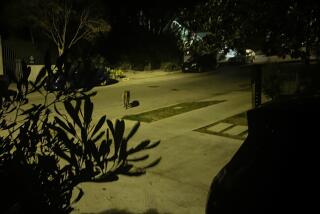City to Review Policy Against Coyote Trapping
- Share via
WOODLAND HILLS — Susan Klenner awoke Sunday to find a “snowstorm” of white feathers and the savaged carcasses of her last eight pet chickens strewn around the back yard of her family’s Woodland Hills home--the gruesome result, she said, of a nocturnal visit by prowling coyotes.
The family called the Los Angeles Department of Animal Regulation for help. But the answer was the same as it was when two of the family’s birds disappeared in separate incidents around Christmas: The city of Los Angeles is no longer in the coyote-trapping business.
Today, largely as a result of complaints by San Fernando Valley residents like Klenner, the city Board of Animal Regulation will begin reconsidering the 6-month-old policy against trapping. The hearing is scheduled for 10 a.m. at 419 S. Spring St. in downtown Los Angeles. And on Jan. 24, the board will have a public hearing in the Valley on the controversial issue.
But for the 54-year-old Klenner, who spent Sunday morning picking up what remained of the decorative animals she considered pets, the city’s discussion is coming more than a little late. “I went out there and it was carnage,” Klenner said. Had the city been able to place traps after the previous attacks, “this probably would not have happened,” she said.
For years, Animal Regulation had routinely responded to residents’ coyote complaints, with officers providing and even setting the traps. But that ended in late June, when former Mayor Tom Bradley’s departing animal board members, at the urging of animal rights activists, halted the practice.
Now, animal control officers simply offer advice on how to prevent attacks and tell residents to contact government agencies that still trap coyotes in certain areas.
The current panel, with most of its members appointed by Mayor Richard Riordan, is free to set its own policy. But department officials and animal board member Lynne Exe, who has publicly favored a resumption of city trapping, doubt the current five-member board will change the policy, complaints from Valley residents notwithstanding.
“If it continues like this, there’s going to be some severe damage to somebody,” said city Animal Regulation Lt. Richard Felosky, who is in charge of the city’s West Valley Animal Care and Control Center in Chatsworth. After hearing about Klenner’s report Sunday, a frustrated Felosky said he favors trapping but is bound by city policy.
Wildlife activists have argued that the city should not be in the business of managing wild animals. They say the traps used to catch the coyotes--although supposedly more humane than those used in the past--can cause severe pain to the animals. In addition, one animal board member has estimated that it would cost the city about $100,000 a year to resume trapping.
However, Klenner said she and others in her Woodland Hills neighborhood who have also lost animals to suspected coyote attacks want the city to reinstate trapping. In the 23 years that she, her husband and son have lived in their flatlands house, they always have kept animals but never had a coyote problem until this year, Klenner said.
“It’s not legitimate to say we’ve moved into coyote habitat,” she said. Animal control officials said the halt to city trapping, the abundance of food and small animals found in residential areas and the recent brush fires that consumed wildlands have combined to drive coyotes into Valley neighborhoods and spurred complaints.
Los Angeles Councilwoman Laura Chick, who represents Woodland Hills and last week pressed the department for the Valley public hearing, said she has been getting complaints from constituents. Chick expressed concern about the city’s cost to resume trapping and added, “I’m not convinced yet that trapping is going to control the problem effectively.”
“There’s a lot of stuff clouding this issue, emotions and fear,” Chick said. And the councilwoman believes “one of the most effective ways” to avoid coyote attacks is for residents to take preventive measures, such as not leaving food out and keeping small domestic animals in fenced areas at night.
To get to her eight white silky chickens, small birds that have silky, hair-like feathers, Klenner said the coyotes had to scramble over two fences, including a five-foot chain-link that surrounded the corral where the birds roosted. From Saturday evening to Sunday morning, the family was home but heard no disturbance outside.
When she went outside Sunday morning, Klenner said, “from a distance, I saw a patch of what sort of resembled snow on the ground. And I knew instantly I had a lot of dead chickens.”
Although other predators are known to kill chickens, Klenner said she is convinced that her birds’ attackers were coyotes, even though she found no firm proof.
Klenner’s son videotaped the scene Sunday morning and she took pictures to show to city officials. Klenner said that if she replaces the birds, she has no intention of keeping them in cages at night to ensure their safety. “That’s not the way I choose to keep birds,” she said.
More to Read
Sign up for Essential California
The most important California stories and recommendations in your inbox every morning.
You may occasionally receive promotional content from the Los Angeles Times.










